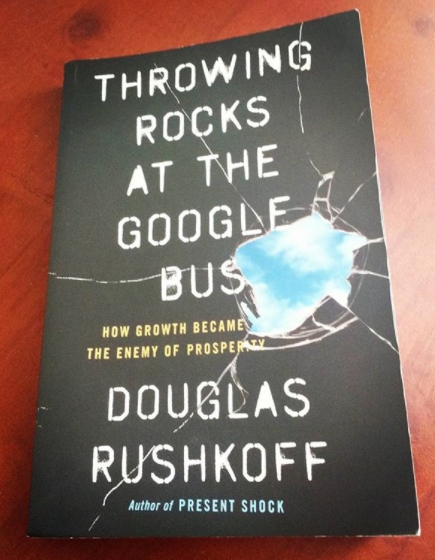Douglas Rushkoff
At the beginning of the third chapter, the author asks us to imagine a world where there is only one operating system. In such a world, it would be difficult to imagine another OS, or even think of the OS as something that need not be the way it is. That, in a nutshell, is what money has become. “Central currency is the transactional tool that has overwhelmed business itself; money is the tail wagging the economy’s dog” because “money makes money faster than people or companies can create value”. The proof of it is in the abstractions that have come up in history – the stock exchange was an abstraction of commerce, and the derivatives market its further abstraction. The author notes how fitting it was when in 2013, a derivatives exchange had enough ‘value’ to buy the NYSE, its own creator of sorts!
My introductory paragraph, and the title itself might give you the idea that this is some kind of a call for a bloody revolution against capitalism and technology. But it isn’t. The title is based on an incident in 2013 and in fact, the author notes how Google, using its buses, is actually doing its bit to protect the environment. He proceeds to ask “since when has doing the right thing become the wrong thing?” The buses, he argues, are soft targets, and the real culprit is a program that promotes growth above all else. So if the book is a call for revolution, it is against the concept of growth for growth’s sake, because such growth is the enemy of prosperity.
The author traces the origins of the central currency – from the time the aristocracy, concerned about the independence of the marketplace, decided to appropriate ‘growth’ for themselves by issuing ‘coins of the realm’. The earliest corporation became the device to use capital to grow itself, and pretty soon, it became far more dominant than the two other factors of production – land and labour. Because, of the three, only capital was conducive to the possibility of infinite growth through extraction of value.
The original corporation was succeeded by colonialism, then the recent industrial corporation, and now, platform monopolies. e.g. Uber, Facebook
The latter part of the book focuses more on how we can get out of the infinite growth trap and create more sustainable ways of growth that are more participative. For instance, move from platform monopolies to protocols like blockchain that are more independent, and create boundaries of growth. Obviously there are challenges, perhaps best illustrated by Wall Street’s attempts to make speculative money on bitcoin and thus, completely missing the point.
The framing and articulation of the problem is fantastic and while it can be argued that the solutions can at times appear naive, I really cannot fault the thought process, and frankly, I’d say expecting one mind to suddenly come up with a solution for a problem that has been building up for centuries is what is naive! This book is a splendid perspective on what is going wrong, and makes a great case for rectifying it and creating distributed, sustainable prosperity.


Leave a Reply